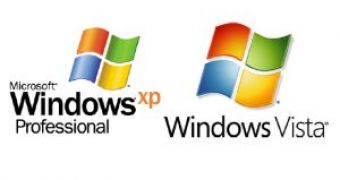Call it a sign of desperation, a new attempt to blow some wind in the sails of its latest platform, or a reaction to the proverbial last drop, but Microsoft is delivering its own perspective in terms of the comparison between its two Windows clients sharing the vast majority of the operating system market. Just ahead of the availability cut-off date for Windows XP through the OEM and retail channels, the Redmond company has "come out gunning" in a move designed to settle once and for good the XP vs. Vista face-off. And what better way for Microsoft to do this but with a Windows XP Professional Service Pack 3 vs. Windows Vista Service Pack 1 comparison? Microsoft's point of view of Vista SP1 vs. XP SP3 is focused on Vista's advances in areas such as security, management, deployment, mobility, and productivity. And believe or not, but Microsoft is doing it all for its customers, in order to help them adjust their expectations.
"During the past year, Microsoft and its ecosystem have made great progress in improving the overall quality and performance of Windows Vista, making the Windows Vista Service Pack 1 (SP1) release a key milestone for broad enterprise deployments of Windows Vista. Microsoft recommends that all business customers who have not started to evaluate Windows Vista should start deployment planning and piloting Windows Vista with SP1. Windows Vista offers customers unique value from increased security and data protection to improved mobility and productivity to capabilities that customers can use to optimize desktop infrastructures and reduce management costs," reads a fragment of the Redmond company's Vista SP1 vs. XP SP3 feature comparison whitepaper available for download here.
In the same month that Microsoft released Service Pack 1 for Vista to the general public, March 2008, the company touted in passing the 140 million sold licenses milestone. At the same time, internal Microsoft concerns surfaced of how customers, especially in the corporate environments, were failing to embrace Vista. The vast majority of new Vista users acquired the operating system preloaded on new machines instead of dropping XP for the "newer model."
What Microsoft is seeing is that customers who are not upgrading their hardware infrastructure are also sticking with Windows XP instead of making the jump to Vista. Unless users buy new computers, they are not upgrading to Windows Vista at all. For the Redmond company, this means that customers will most likely update Windows XP to Service Pack 3, available as of May 6, and ride the operating system for all it's got until the next version of Windows, labeled Windows 7, drops, sometime in the 2009 - 2010 timeframe. Even though XP Sp3 is still very much Windows, and Microsoft will be able to at least conserve its share of the operating system market, inexistent Vista upgrades translate to lost business for the Client division. Not a dramatic loss, as over 80% of the Client revenue comes from sales of OEM machines with Windows pre-loaded, but sufficient so that Microsoft would perform its very own XP SP3 vs. Vista SP1 comparison. At the same time, customers that are sticking with Windows XP on older hardware instead of upgrading their IT infrastructure and migrating to Vista are the ones really hurting Microsoft.
"Microsoft knows that many customers will adopt Windows Vista gradually, through hardware refreshes (i.e., attrition). During hardware refresh, customers will co-manage Windows Vista and Windows XP. Enhancements to Windows XP with Service Pack 3 (SP3), such as Network Access Protection (NAP), make it easier for customers to more securely integrate both operating systems into their environments. During the transition, using Windows XP with SP3 will help ensure that client computers still running the Windows XP operating system have the most recent security and software updates," Microsoft added.
The Windows XP SP3 vs. Vista SP1 feature comparison covers a few areas of the operating systems from security to management, deployment, mobility, productivity and focuses on items such as: Security Development Lifecycle (SDL); Defense in depth; Windows BitLocker Drive Encryption; Windows Firewall; Internet Explorer 7 Protected Mode; ActiveX Installer Service; Group Policy; Standard user accounts; Reliability and diagnostics; Event management; Task scheduling; Image-based setup (IBS); Deployment, compatibility, and asset-inventory tools; Windows Setup; Worldwide single-image deployment; Windows Mobility Center; Sync Center; Offline files; Network Projection; Secure Sockets Tunnel Protocol (SSTP); Power management; Wireless networking; Search and User interface and navigation.
The whitepaper can be downloaded from here.
Windows Vista Service Pack 1 Five Language Standalone for both 32-bit and 64-bit versions of the operating system is available for download HERE. Windows XP Service Pack 3 stand-alone version is available for download HERE.

 14 DAY TRIAL //
14 DAY TRIAL //